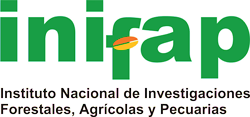Enhancing trefoil germination under metal stress through Bradyrhizobium sp. (Lotus) inoculation
DOI:
https://doi.org/10.29312/remexca.v16i4.3658Keywords:
cadmium, copper, PGPR, physiologyAbstract
This study investigates the effect of inoculation with Bradyrhizobium sp. (Lotus), a symbiotic rhizobacterium, on the germination of trefoil under stress induced by copper, cadmium, and their combination. The goal is to highlight the role of Bradyrhizobium sp. (Lotus) in mitigating copper and cadmium stress and enhancing the germination of trefoil, a spontaneous fodder species. The research, conducted in Blida (Algeria) in 2024, focuses on the physiological aspects of germination, including Total Germination Count (TCG), Time to mean germination (TMG), and inhibition of germination reversibility. Statistical analysis was performed using Manova at a 5% threshold. Results indicate that Bradyrhizobium sp. (Lotus) inoculation increases TCG values and reduces the germination lag phase from +168 h to 48 h. Additionally, germination inhibition is decreased by 20 to 30% compared to non-inoculated seeds, and physiological germination parameters improve under metal stress conditions. The findings suggest that Bradyrhizobium sp. (Lotus) may mitigate copper and cadmium stress by detoxification or chelation, thereby enhancing trefoil tolerance to these metallic trace elements during the germination stage.
Downloads
References
Ashraf, M. and Foolad, M. R. 2007. Roles of glycine betaine and proline in improving plant abiotic stress resistance. Journal of Experimental Botany. 59(2):206-216.
Barassi, C. A.; Ayrault, G.; Creus, C. M.; Sueldo, R. J. and Sobrero, M. T. 2006. Seed inoculation with Azospirillum mitigates NaCl effects on lettuce. Scientia Horticulturae. 109(1):8-14.
Bennani, K. and Bendaou, N. 2015. Influence de la salinité en plein champ sur la teneur en phytoestrogènes et la germination d’écotypes marocains de Trifolium. Canadian Journal of Plant Science. 95(3):461-466.
Brockwell, J.; Pilka, A. and Holliday, R. A. 2005. Soil restoration through the introduction of legumes in degraded land. Plant and Soil. 270(1-2):251-264.
Come, D. 1970. Obstacles to germination. Ed. Masson et Cie. 162 p.
Croteau, M. N.; Luoma, S. N. and Stewart, A. R. 2005. Trophic transfer of metals along freshwater food webs: Evidence of cadmium biomagnification in nature. Limnology and Oceanography. 50(5):1511-1319.
De-Forest, D. K.; Brix, K. V. and Adams, W. J. 2007. Assessing metal bioaccumulation in aquatic environments: the inverse relationship between bioaccumulation factors, trophic transfer factors and exposure concentration. Aquatic Toxicology. 84(2):236-246.
Degaichia, H.; Boussahoua, A. R. and Bakria, T. 2024. Resistance of Bradyrhizobium sp. (Lotus) to metallic stress. Agropastoralis Scientia. 1(2):73-83.
Ernst, W. H. O. 1998. Effects of heavy metals in plants at the cellular and organismic level ecotoxicology. In: Gerrit, S. & Bernd, M. Ed. Bioaccumulation and biological effects of chemicals, John Wiley & Sons and Spektrum Akademischer Verlag. 587-620 pp.
Fernandes, J. C. and Henriques, F. S. 1991. Biochemical, physiological and structural effects of excess copper in plants. Botanical Review. 57(1):246-273.
Mihoub, A.; Chaoui, A. and Ferjani, E. 2005. Biochemical changes induced by cadmium and copper during germination of pea seeds (Pisum sativum L.). Comptes Rendus Biologies. 328 p.
Mills, A. L. and Colwell, R. R. 1977. Microbiological effects of metal ions in Chesapeake Bay and sediments. Bulletin of Environmental Contamination and Toxicology. 18(1):99-103.
Nelson, L. M. 2004. Plant growth promoting rhizobacteria (PGPR): prospects for new inoculants. Crop Management. 3(1):1-7.
Osborne, J. M.; Fox, J. E. D. and Mercer, S. 1993. Germination response under elevated salinities of six semi-arid blue bush species (Western Australia). In: Lieth, H. & Masoom, A. Al. Ed. Towards the rational use of high salinity plants. 323-338. pp
Silini, A.; Cherif-Silini, H. and Yahiaoui, B. 2016. Growing varieties durum wheat (Triticum durum) in response to the effect of osmolytes and inoculation by Azotobacter chroococcum under salt stress. African Journal of Microbiology Research. 10(12):387-399.
Smýkal, P.; Vernoud, V.; Blair, M. W.; Soukup, A. and Thompson, R. D. 2015. The role of the legume Lotus spp. in sustainable agriculture and ecological restoration. Critical Reviews in Plant Sciences. 34(1-3):43-80.
Somasegaran, P. and Hoben, H. J. 1994. Handbook for rhizobia. Springer Verlag New York Inc. 450 p.
Vincent, J. M. 1970. A manual for the practical study of the root-nodule bacteria. IBP Handbook No. 15. Blackwell Scientific Publishers. 154 p.
Woolhouse, H. W. 1983. Toxicity and tolerance in the responses of plants to metals. In O. L. Lange, P. S. Nobel, C. B. Osmond, & H. Ziegler Ed. Encyclopaedia of Plant Physiology, New Series 12C. Springer-Verlag. 245-300 pp.

Published
How to Cite
Issue
Section
License
Copyright (c) 2025 Revista Mexicana de Ciencias Agrícolas

This work is licensed under a Creative Commons Attribution-NonCommercial 4.0 International License.
The authors who publish in Revista Mexicana de Ciencias Agrícolas accept the following conditions:
In accordance with copyright laws, Revista Mexicana de Ciencias Agrícolas recognizes and respects the authors’ moral right and ownership of property rights which will be transferred to the journal for dissemination in open access. Invariably, all the authors have to sign a letter of transfer of property rights and of originality of the article to Instituto Nacional de Investigaciones Forestales, Agrícolas y Pecuarias (INIFAP) [National Institute of Forestry, Agricultural and Livestock Research]. The author(s) must pay a fee for the reception of articles before proceeding to editorial review.
All the texts published by Revista Mexicana de Ciencias Agrícolas —with no exception— are distributed under a Creative Commons License Attribution-NonCommercial 4.0 International (CC BY-NC 4.0), which allows third parties to use the publication as long as the work’s authorship and its first publication in this journal are mentioned.
The author(s) can enter into independent and additional contractual agreements for the nonexclusive distribution of the version of the article published in Revista Mexicana de Ciencias Agrícolas (for example include it into an institutional repository or publish it in a book) as long as it is clearly and explicitly indicated that the work was published for the first time in Revista Mexicana de Ciencias Agrícolas.
For all the above, the authors shall send the Letter-transfer of Property Rights for the first publication duly filled in and signed by the author(s). This form must be sent as a PDF file to: revista_atm@yahoo.com.mx; cienciasagricola@inifap.gob.mx; remexca2017@gmail.
This work is licensed under a Creative Commons Attribution-Noncommercial 4.0 International license.


